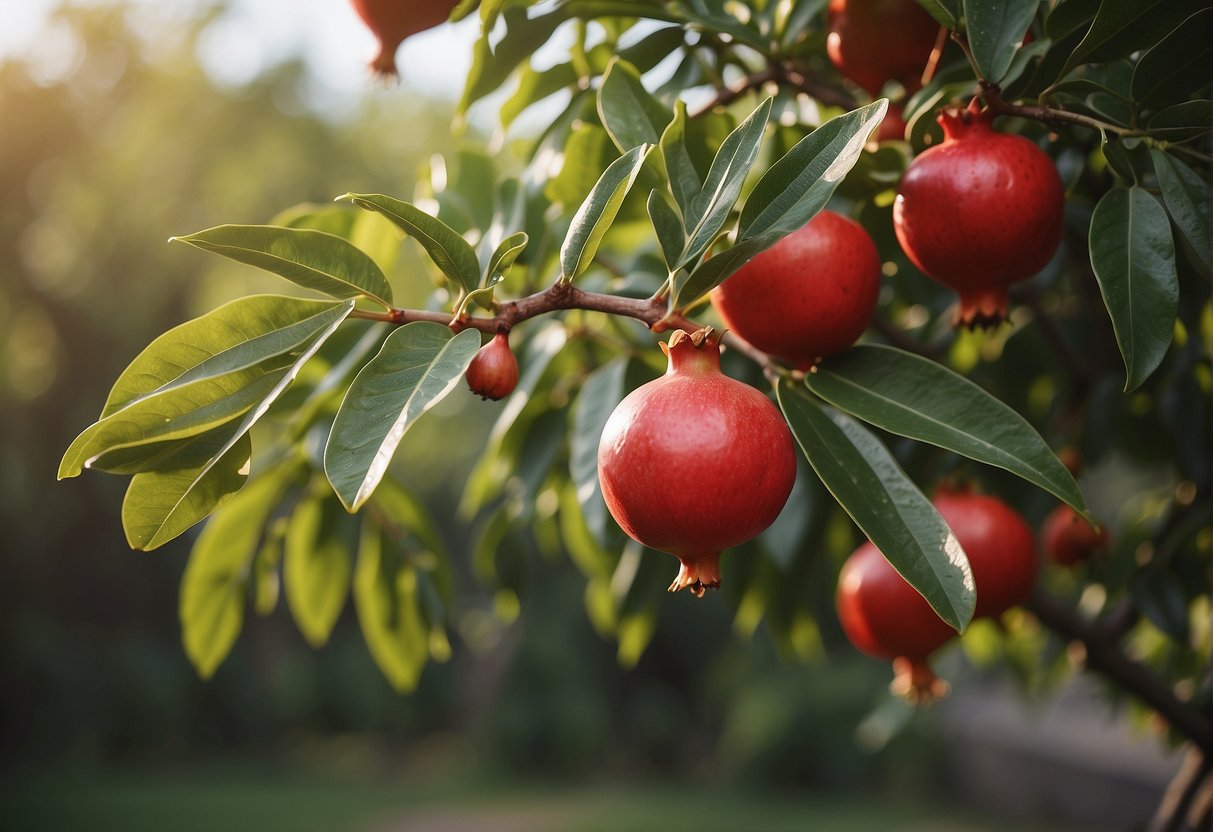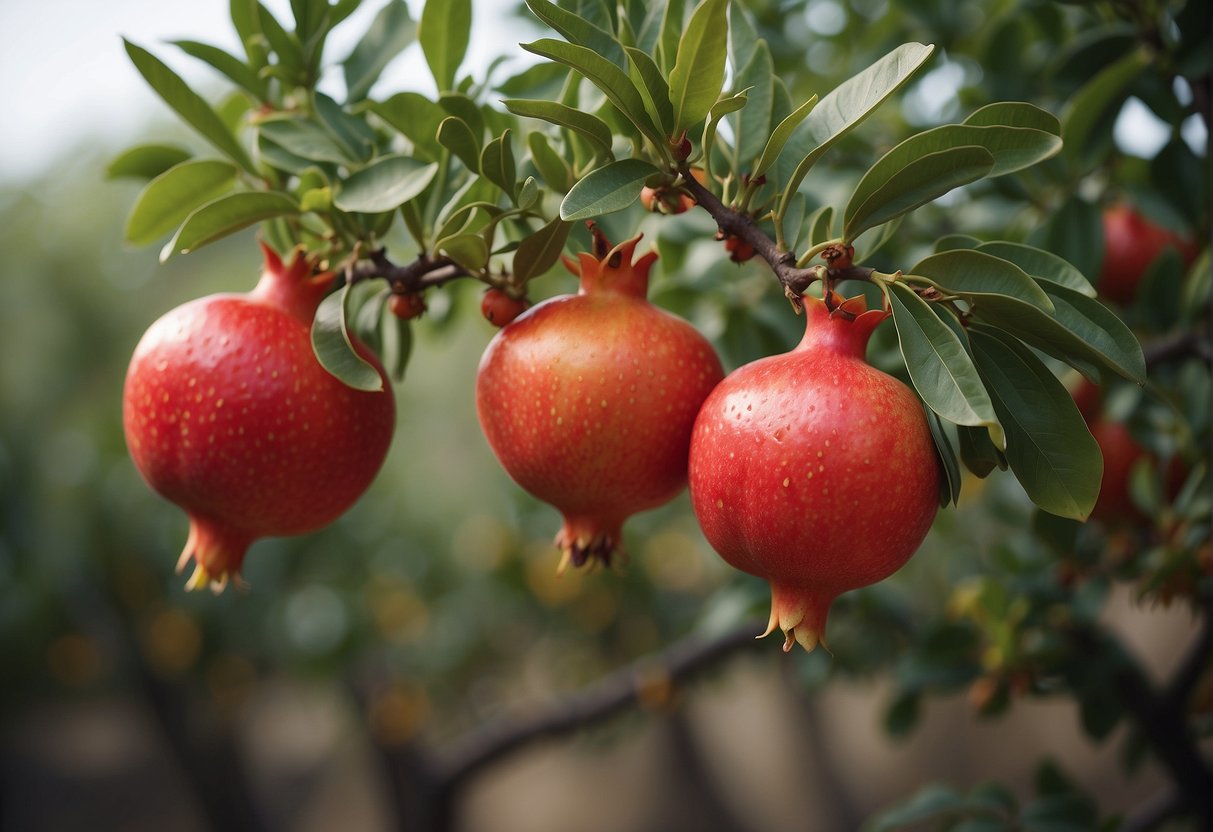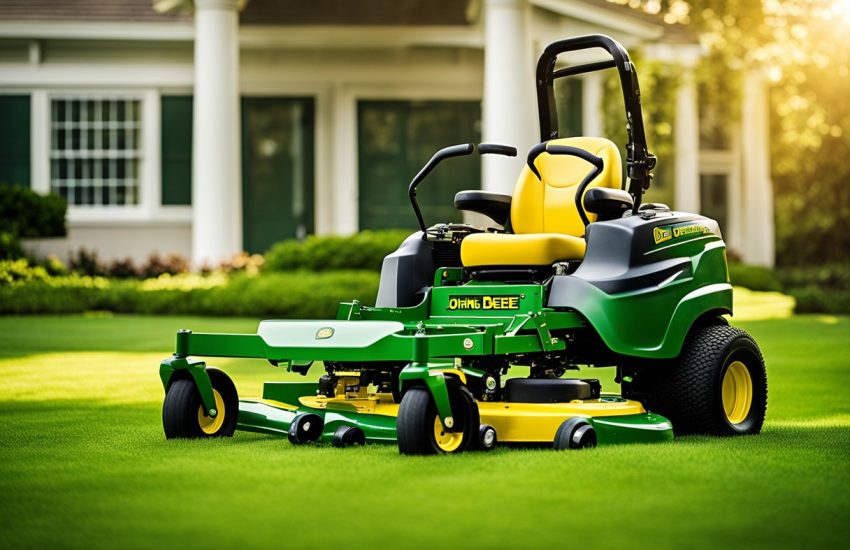Full Grown Pomegranate Tree: Everything You Need to Know
A full-grown pomegranate tree is a sight to behold. With its vibrant green leaves and bright red fruit, it is a beautiful addition to any garden or orchard. Pomegranate trees are native to the Middle East and have been cultivated for thousands of years for their delicious fruit.

A mature pomegranate tree can reach up to 20 feet tall and 15 feet wide, with a trunk diameter of up to 6 inches. The tree produces small, glossy leaves and vibrant orange-red flowers that bloom in the spring and summer. As the flowers fade, they are replaced by the distinctive fruit, which grows to be about the size of a large orange. The fruit is filled with juicy, ruby-red seeds that are packed with antioxidants and other nutrients. Pomegranate trees are hardy and can grow in a variety of climates, from hot and dry to cool and humid. They require full sun and well-drained soil to thrive, but once established, they are relatively low-maintenance. With proper care, a full-grown pomegranate tree can produce up to 100 pounds of fruit per year, making it a valuable addition to any home garden or commercial orchard.
Cultivation and Care
Planting and Location
When planting a full grown pomegranate tree, it is important to choose a location that receives full sun. Pomegranate trees are deciduous in cooler climates and evergreen in warmer climates, and they require at least six hours of direct sunlight daily to thrive. The soil should be well-drained, and the tree should be planted in a location with good air circulation. Pomegranate trees can be grown in pots, but they should be transplanted into larger containers as they grow.
Watering and Fertilizing
Pomegranate trees require regular watering, especially during the first year of growth. The soil should be kept moist but not waterlogged, and pomegranate trees benefit from regular applications of fertilizer. A balanced fertilizer can be applied in the spring and summer months, and a layer of compost or mulch can be added to the soil to help retain moisture.
Pruning and Maintenance
Pomegranate trees require minimal pruning, but it is important to remove any suckers that grow from the base of the tree. Dead or damaged branches should also be pruned as needed. Pomegranate trees are generally disease-resistant, but they can be susceptible to pests such as aphids and whiteflies. If pests are present, spraying the tree with a mild soap solution can help to control the infestation.
Climate and Temperature
Pomegranate trees are cold hardy and can be grown in USDA hardiness zones 7-12. They can tolerate temperatures as low as 10°F (-12°C) but prefer temperatures between 40-85°F (4-29°C). Pomegranate trees require a moderate amount of humidity and can tolerate windy conditions.
Propagation and Growth
From Seed to Tree
Growing a pomegranate tree from seed is a relatively easy process, but it requires patience. The seeds should be collected from a ripe fruit and washed thoroughly. Once cleaned, they can be planted in a well-draining soil mix with a pH between 5.5 and 7.0. It is important to keep the soil moist but not waterlogged.
After planting, the seeds should be covered with a thin layer of soil and placed in a warm and sunny location. Germination can take anywhere from two weeks to several months. Once the seedlings have grown to around 6 inches in height, they can be transplanted into larger pots or directly into the ground.
Cuttings and Grafting
Propagation through cuttings or grafting is a more reliable method of growing pomegranate trees. Cuttings should be taken from a healthy and mature tree during the dormant season. The cuttings should be around 8 inches long and have a diameter of at least 1/4 inch.
The cuttings should be planted in a well-draining soil mix with a pH between 5.5 and 7.0. They should be kept in a warm and humid location until they start to grow new leaves. Once the cuttings have rooted and started to grow, they can be transplanted into larger pots or directly into the ground.
Grafting involves attaching a cutting from a desired variety onto the rootstock of another tree. This method allows for precise control over the characteristics of the resulting tree, but it requires specialized knowledge and equipment.
Container Growing
Pomegranate trees can also be grown in containers, making them suitable for balconies or greenhouses. The container should be at least 18 inches in diameter and have drainage holes. A well-draining soil mix with a pH between 5.5 and 7.0 should be used.
Container-grown trees require regular watering and fertilization. They should be placed in a sunny location and rotated every few weeks to ensure even growth. Pruning may be necessary to keep the tree at a manageable size.
Harvesting and Usage

Fruit Production and Harvest
Full grown pomegranate trees, whether grown as a bush, shrub, or hedge, can produce an abundance of fruits. The most popular cultivar is the Wonderful variety, which is known for its large, sweet, and juicy arils. Pomegranate fruits are typically harvested in late summer to early fall, when they are fully ripe and have a deep red color.
When harvesting pomegranates, it is important to handle them with care as their skin can easily crack and the arils can be damaged. To harvest, gently twist the fruit off the tree or use pruning shears to cut the stem. Once harvested, the fruits can be stored in a cool and dry place for up to several weeks.
Culinary and Other Uses
Pomegranate fruits are not only delicious but also packed with nutrients and antioxidants. The sweet and tart arils can be eaten fresh or used in a variety of recipes, such as salads, desserts, and drinks. Pomegranate juice is also a popular ingredient in smoothies, cocktails, and teas.
Apart from culinary uses, pomegranate fruits and extracts are used in traditional medicine for their potential health benefits, such as reducing inflammation and improving heart health. Pomegranate extracts are also used in cosmetic products for their antioxidant and anti-aging properties.
In conclusion, full grown pomegranate trees are a valuable addition to any garden or landscape. With proper care and maintenance, they can produce an abundance of delicious and nutritious fruits that can be enjoyed in various ways.
Pest, Disease, and Environmental Management

Common Pests and Diseases
Full-grown pomegranate trees can be susceptible to various pests and diseases. Aphids are a common pest that can cause damage to the leaves and fruit. Heart rot is a disease that can affect the fruit and cause it to rot from the inside out. To prevent these issues, it is important to maintain good tree health through regular fertilization and proper maintenance.
Drought-tolerant varieties of pomegranate trees are less susceptible to disease and pests, making them a good option for areas with low rainfall. It is also important to ensure proper spacing between trees to prevent overcrowding, which can lead to increased humidity and the spread of disease.
Environmental Stress Factors
Environmental stress factors such as rain, humidity, wind, and sunlight can also affect the health of a full-grown pomegranate tree. Excessive rainfall can lead to root rot, while high humidity can promote the growth of fungal diseases. Strong winds can damage the branches and fruit, while excessive sunlight can cause sunburn on the fruit.
Proper landscaping and companion planting can help mitigate some of these stress factors. For example, planting windbreaks can protect the tree from strong winds, while planting shade trees can provide relief from excessive sunlight. Regular maintenance and monitoring of the tree’s health can also help prevent and manage environmental stress factors.
Frequently Asked Questions

What are the essential care tips for a mature pomegranate tree?
Mature pomegranate trees require minimal care once they are established. They thrive in well-draining soil with full sun exposure. Watering should be done once a week in the absence of rainfall. Pruning is necessary to remove dead or diseased branches and to shape the tree. Fertilizer should be applied once a year in the spring.
What is the growth rate of pomegranate trees?
Pomegranate trees grow slowly, with an average growth rate of 1 to 2 feet per year. However, growth rate can vary depending on the variety of the tree and the growing conditions.
Can pomegranate trees be effectively grown in containers?
Yes, pomegranate trees can be grown in containers. However, the container should be at least 18 inches in diameter to accommodate the tree’s root system. Potted trees require more frequent watering and fertilization than those planted in the ground.
What is the process for cultivating a pomegranate tree from seed?
To cultivate a pomegranate tree from seed, the seeds must be extracted from a ripe fruit and cleaned of any pulp. The seeds should then be planted in a well-draining soil mixture, kept moist, and placed in a warm, sunny location. Germination can take up to 6 weeks.
At what size is a pomegranate tree considered fully mature?
Pomegranate trees can reach a height of 12 to 16 feet and a spread of 12 to 14 feet. They are considered fully mature when they reach this size and begin to produce fruit, which typically occurs 3 to 4 years after planting.
Is cross-pollination necessary for pomegranate trees to fruit?
Pomegranate trees are self-pollinating and do not require cross-pollination to produce fruit. However, cross-pollination can increase fruit set and improve fruit quality.

